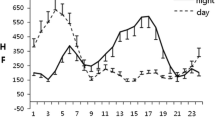Abstract
Operators of both sexes employed in the pulp industry were examined during a triple-shift cycle of shift work. Changes in the body temperature, heart rate, blood pressure, and sensorimotor coordination parameters were used as indicators of the circadian rhythms of their physiological functions. Sex-related differences were found with respect to a number of parameters (the muscular strength, critical flicker frequency, duration of the performance of a coordination test and coordination index, blood pressure and autonomic index, and physical general condition and mood scores). Fatigue in this type of operator activity was efficiently detected by the general condition, activity, mood (WAM) test score (especially in women), the number of errors in the test for sensorimotor coordination, and the coordination index.
Similar content being viewed by others
References
Navakatikyan, A.O., Sytnik, N.I., and Kal’nish, V.V., Optimization of Shift Work: Shift Schedules: A Review, Med. Truda Prom. Ekol., 1995, no. 1, p. 22.
Smirnov, K.M., Navakatikyan, A.O., Gambashidze, G.M., et al., Bioritmy i trud (Biorhythms and Labor), Leningrad: Nauka, 1980.
Ruttenburg, S.O. and Slonim, A.D., Tsirkadnyi ritm fiziologicheskikh protsessov i trudovaya deyatel’nost’ cheloveka (Circadian Rhythm of Physiological Processes and Occupational Activity), Frunze: Ilim, 1976.
Delaryu, V.V. and Davydenko, L.A., Psychophysiological Estimation of Night Work as Exemplified by Operators in Modern Acrolein Production, in Aktual’nye problemy fiziologii truda i profilakticheskoi ergonomiki (Current Problems in Occupational Physiology and Preventive Ergonomics) (Abstr. IX All-Union Conference), Moscow, 1990, vol. II, p. 72.
Matyukhin, V.V., Yushkova, O.I., Kas’yanova, I.N, et al., Effect of Three-Shift Work on the Functional State of Operators Dealing with Modern Technologies, in Aktual’nye problemy fiziologii truda i profilakticheskoi ergonomiki (Current Problems in Occupational Physiology and Preventive Ergonomics) (Abstr. IX All-Union Conference), Moscow, 1990, vol. III, p. 70.
Kuznetsov, G.B., Solonin, Yu.G., and Maslentseva, S.B., Expression of Circadian Rhythms of Some Physiological Functions in Persons Engaged in hard Labor in Different Shifts, in Nauchnye raboty institutov okhrany truda VTsSPS (Research Works of Istitutes of Labor Protection of the All-Union Central Council of Trade Unions), Moscow: Profizdat, 1975, issue 96, p. 57.
Fischer, F.M., What Do Petrochemical Workers, Healthcare Workers, and Truck Drivers Have in Common? Evaluation of Sleep and Alertness in Brazilian Shiftworkers, Cad Saude Publica, 2004, vol. 20, no. 6, p. 1732.
Rouch, I., Wild, P., Ansiau, D., and Marquie, J.C., Shiftwork Experience, Age and Cognitive Performance, Ergonomics, 2005, vol. 48, no. 10, p. 1282.
Morgan, L., Hampton, S., Gibbs, M., and Arendt, J., Circadian Aspects of Postprandial Metabolism, Chronobiol. Int., 2003, vol. 20, no. 5, p. 795.
Kulikov, V.V., Fridman, Y.M., and Fomin, A.N., Role of Oxidative Stress in Mechanisms of Premature Aging in Shift Labor Workers, Alaska Med., 2007, vol. 49, no. 2, p. 81.
Sookoian, S., Gemma, C., Fernandez, G.T., et al., Effects of Rotating Shift Work on Biomarkers of Metabolic Syndrome and Inflammation, J. Int. Med., 2007, vol. 261, no. 3, p. 285.
Colligan, M.J. and Tepas, D.I., The Stress of Hours of Work, Am. Ind. Hyg. Assoc. J., 1986, vol. 47, no. 11, p. 686.
Peate, I., Strategies for Coping with Shift Work, Nurs. Stand., 2007, vol. 22, no. 4, p. 42.
Franzese, E. and Nigri, G., Night Work As a Possible Risk Factor for Breast Cancer in Nurses. Correlation Between the Onset of Tumors and Alterations in Blood Melatonin Levels, Prof. Inferm., 2007, vol. 60, no. 2, p. 89.
Gigiena truda zhenshchin (Women’s Occupational Hygiene), Izmerov, N.F. and Khoiblain, Kh.-G., Eds., Moscow: Meditsina, 1985.
Solonin, Yu.G., Teh Role of Dimensionality in Sex-Related Differences in Autonomic Responses to Physical Load, in Vzaimodeistvie dvigatel’nykh i vegetativnykh funktsii pri myshechnoi aktivnosti: Sb. nauch. tr. Tverskogo gos. un-ta (Interaction between Motor and Autonomic Functions in Muscular Activity: Proceedings of the Tver State University), Tver, 1990, p. 122.
Solonin, Yu.G., Age Dynamics of Some Physiological Functions in Residents from Polar Regions, Fiziol. Chel., 1998, vol. 24, no. 1, p. 98 [Human Physiol. (Engl. Transl.), vol. 24, no. 1, p. 88].
Navakatikyan, A.O. and Kryzhanovskaya, V.V., Vozrastnaya rabotosposobnost’ lits umstvennogo truda (Age-Related Changes in Working Capacity in Persons Engaged in Intellectual Work), Kiev: Zdorov’e, 1979.
Rukovodstvo po gigienicheskoi otsenke faktorov rabochei sredy i trudovogo protsessa. Kriterii i klassifikatsiya uslovii truda. Rukovodstvo R 2.2.2006-05 (Guidelines for Hygienic Assessment of the Factor of Working Environment and Work: Criteria and Classification of Working Conditions. Guidelines R 2.2.2006-05), Moscow, 2005.
Inoue, M., Fujimura, T., Morita, H., et al., A Comparison of Heart Rate During Rest and Work in Shift Workers with Different Work Styles, Ind. Health, 2003, vol. 41, no. 4, p. 343.
Hydrogen Oxide, in Entsiklopediya po bezopasnosti i gigiene truda (Encyclopedia of Occupational Safety and Hygiene), Moscow: Profizdat, 1987, vol. 4, part 2, p. 2220.
Medvedev, V.I., Adaptatsiya cheloveka (Human Adaptation), St. Petersburg: Institut Mozga Cheloveka, 2003.
Author information
Authors and Affiliations
Additional information
Original Russian Text © Yu.G. Solonin, E.R. Boiko, T.P. Loginova, O.A. Ketkina, 2009, published in Fiziologiya Cheloveka, 2009, Vol. 35, No. 4, pp. 51–56.
Rights and permissions
About this article
Cite this article
Solonin, Y.G., Boiko, E.R., Loginova, T.P. et al. Circadian rhythms of physiological functions in men and women as related to shift work. Hum Physiol 35, 437–441 (2009). https://doi.org/10.1134/S0362119709040070
Received:
Published:
Issue Date:
DOI: https://doi.org/10.1134/S0362119709040070




